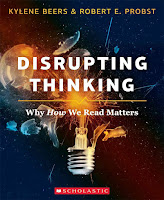 |
| Disrupting Thinking by Kylene Beers and Robert Probst |
These are two reading gurus, if you are not familiar with them. Their style of writing is easy to understand and super relatable. One of the big take-aways I have hit on so far is the importance of knowing how we (and our students/children) respond to what we read. They have two terms that were new to me, but I will be using -- aesthetic reading and efferent reading.
Basically, aesthetic reading is being alert to what the text is doing to us - what feelings does the text elicit and what do we do in response to those feelings? Efferent reading is reading to simply extract information, like when we read directions to put together a bookshelf.
So, when we read, we respond by laughing, crying, getting angry, or even being motivated to do something. And all this goes back to showing how well we comprehend what we read. But it also relates to being what Beers and Probst call a responsible reader. This is a reader who can examine their reactions to a text and then use that to test the validity of the text. In the age of "fake news" and social media, our reactions tend to be quick and not always well thought out. But if we take time to really notice and analyze our reactions, we will gain some insight into the text itself.
This is good stuff for grown ups. But it's also great for kids. Because this is what we need to be teaching our readers. And we do that through talking! I had an earlier blog about what questions you could ask your kids about their reading to move past the simple, "What's it about?". Reading this book has added more ideas to this line of thinking. Questions like: "How did that make you feel?" and "What does that make you want to do?" will have us really examining what we took away from a text. It will also give insight into how well you (or your child) understood it. If you ask someone how the story/article/poem made them feel and they say it didn't, that's a red flag. Authors write to elicit feelings. They choose their craft moves very specifically. Authors of "fake new" specifically are looking to ignite something. They often make very bold statements that are meant to get you feeling strongly. When you click that article on Facebook or Twitter and it gets you all hot and bothered, stop and think about why! And then talk about it. This is a great time to model aesthetic reading for your growing reader.
As kids get older, reading to them becomes harder to do. They want to read on their own and they have specific tastes. But you can still set aside time to talk books with them. And if you are reading together, then make part of that time talk time.
Beers and Probst talk about three types of readers that we want: Responsive, Responsible, and Compassionate. We have to be all of those also!